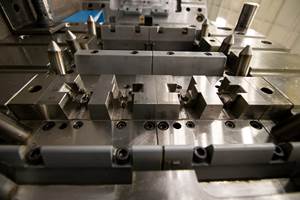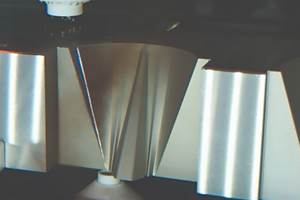Systems Approach to Micromachining and Molding Yields Accuracy
This systems approach to micromachining includes multiple cavities in the molds for the plastic injection over molding portion of the LED manufacturing process.
Share
Read Next
The process of micromachining a moderate amount of tiny complex components, while also holding extremely tight tolerances and generating superior surface finishes, is enough of a daunting challenge in itself. Now, imagine having to do so in a production environment where job volumes run well into the millions and every part must be perfect.
As required part volumes rise to astronomical numbers, accuracy plays an increasingly critical role. All parts must be consistently precise and accurate because checking every single one is simply impossible from a cost standpoint. This places an enormous burden on the manufacturing processes involved, and more specifically on the machine tools used.
One such situation would be high-volume micro parts that are stamped, molded or punched into shape as part of their overall manufacturing process. In these instances, the required mold, die and punch tooling must be machined to exacting standards to ensure that every resulting part is perfect.
However, it should be kept in mind that it is practically impossible to consistently achieve perfect parts from subpar mold, die and punch tooling. This is why all machines used to produce the tooling must operate at the same high accuracies, and their individual machining operations must be coordinated/integrated within the overall tool machining process.
There can be no weak links as far as machine accuracies are concerned. So, instead of struggling with a hodge-podge of different level machines, some manufacturers have opted for complete multiple-machine systems, specifically developed for micromachining mold, die and punch tooling used to produce jobs calling for millions and millions of parts.
A perfect example of such a coordinated multiple-machine tool system is one developed by GF AgieCharmilles for micromachining the tooling used in the combined punching and molding operations involved with producing light emitting diodes (LEDs). The system incorporates three super high-accuracy machine tools: a Mikron HSM 400 LP Precision high-speed, 5-axis milling machine, a Cut 1000 wire EDM and an FO 350 MS die sinking EDM.
The system is a result of close collaborations with multi-national manufacturers of electronic components. Such collaborations allow GF AgieCharmilles to engineer complementary milling and EDMing solutions that meet the specific demands of manufacturers involved with extremely high-volume micromachining operations.
For LEDs, the GF AgieCharmilles system produces tooling with near-perfect surface finishes to eliminate any need for hand polishing, generates high-accuracy pitch angles to increase tooling life, reduces necessary operator intervention, and helps speed the overall tool manufacturing process, notes GF AgieCharmilles Business Development Manager Gisbert Ledvon. “Speed and accuracy are essential when considering the volumes of LEDs needed to be produced—one television uses thousands of LEDs, energy-saving LEDs are replacing incandescent and florescent lighting, and cell phones and computers use LEDs for backlighting,” he explains..
LED components are punched out of strips of metal. The punched pieces then move to a molding process where plastic is molded around them. These processes run at incredibly high speeds, so there can be no inaccuracies between dies, punches and molds.
High-volume production LED die sections are commonly 2 feet long and made up of replaceable sections. All components involved must match up perfectly from one section to the next because punch shapes differ in each progressive section.
For LED production, the Mikron HSM 400 LP Precision micromachines the copper electrodes used by the FO 350 MS die sinking EDM. “These electrodes must be precise for die sinking an accurate multiple molding cavity pattern with sharp exact corners,” Ledvon says. “The locations of the multiple cavities are held to within a micron—thanks to the HSM 400 LP Precision’s 42,000-rpm spindle running tools as small as 0.5 mm in diameter—so that they match up perfectly with the multiple mating punches, which measure 2 mm x 4 mm in size.”
The Mikron HSM 400 LP Precision, as well as the CUT 1000 wire EDM that cuts with wire as small as 0.0008 in. in diameter, is also used to machine the critical features on punches. While the Mikron HSM 400 LP Precision does the hard machining of the reflective surfaces of the final LED elements down to Ra 50 nanometers, the CUT 1000 wire EDM ensures the clearance between punch and die is 1.5 microns (0.00006 in.). There can be as many as 20 punches in one LED die block, and the precise micromachining of their features ensures accurate positioning from one punch to the next and significantly extends their working lives as well as light emitting qualities.
Within the three-machine GF AgieCharmilles system, the FO 350 MS die sinking EDM, in unison with the CUT 1000, machines the multiple cavities in the molds for the plastic injection over molding portion of the LED manufacturing process. For the over molding punches, the FO 350 MS precisely burns the necessary shapes into the ends of punches.
“Today’s engineers and designers continue to develop new and creative ways to incorporate LEDs,” Ledvon concludes. “As a result, production volumes will continue to increase, and integrated multiple-machine systems will provide the flexibility to quickly adapt to those new uses and the accuracy necessary for producing extremely high volumes of not only LED-related parts, but also all other micromachined parts.”
Related Content
Extensive Evaluations Build The Plastek Group’s EDM Arsenal
Sinker and wire EDMs selected for speed, volumetric accuracy, surface finish, reliability, cost of ownership and extensive warranty.
Read More2024 Moldmaking Insights: A Year in Review Part 2
A look back at the top moldmaking trends of 2024, as revealed through MMT's analytics. This review highlights the most popular technical articles, case studies, tips and best practices that captured the industry's attention over the past year.
Read MoreMaintaining a Wire EDM Machine
To achieve the ultimate capability and level of productivity from your wire EDM on a consistent, repeatable and reliable basis, regular maintenance is a required task.
Read MoreSoft Wired: Cutting High Taper Angles with Wire EDM
Examine the wire’s properties to determine the right one for achieving the best cut.
Read MoreRead Next
Are You a Moldmaker Considering 3D Printing? Consider the 3D Printing Workshop at NPE2024
Presentations will cover 3D printing for mold tooling, material innovation, product development, bridge production and full-scale, high-volume additive manufacturing.
Read MoreHow to Use Strategic Planning Tools, Data to Manage the Human Side of Business
Q&A with Marion Wells, MMT EAB member and founder of Human Asset Management.
Read MoreHow to Use Continuing Education to Remain Competitive in Moldmaking
Continued training helps moldmakers make tooling decisions and properly use the latest cutting tool to efficiently machine high-quality molds.
Read More





















